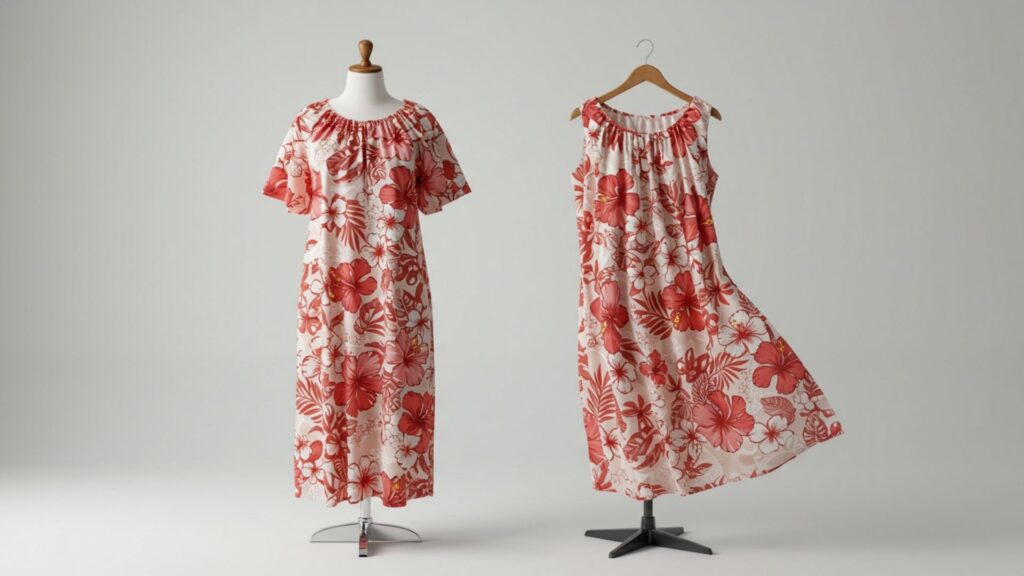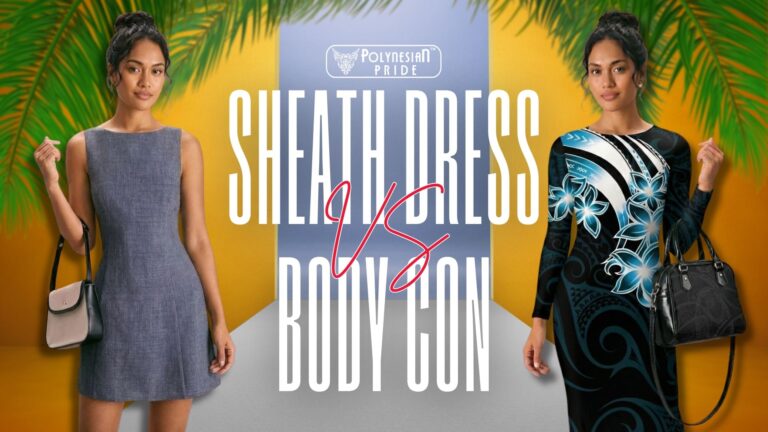What is a Muumuu Dress? Effortless Beauty from Hawaii

INTRODUCTION
What is a Muumuu Dress? More than just a flowy, tropical garment, the muumuu dress is a vivid expression of Hawaiian identity—blending island comfort, colonial history, and cultural pride into one iconic silhouette. Worn by generations of Hawaiian women, it has transformed from modest missionary-era attire into a global fashion symbol seen on beaches, runways, and everyday wardrobes alike.
From its roots in missionary-era Hawaii to high-fashion catwalks and modern wardrobes, the muumuu’s legacy is rich and colorful. In this guide, we’ll explore everything about the muumuu dress: its origins, cultural significance, unique features, contemporary adaptations, and how to style it for any occasion.
What is a Muumuu Dress?

A muumuu dress (pronounced “moo-moo”) is a traditional Hawaiian garment known for its loose, flowing silhouette and lightweight, breathable fabric. Originally adapted from Western-style dresses introduced by Christian missionaries in the 19th century, the traditional Hawaiian muumuu dress quickly became a symbol of everyday elegance and comfort for Hawaiian women. Its unstructured design allows for freedom of movement, making it especially suited for tropical climates and relaxed occasions.
Key Features of a Muumuu:
- Loose Fit: Muumuus fall straight from the shoulders without a defined waistline, providing unrestricted movement and excellent airflow—ideal for warm, humid environments.
- Comfortable Design: Typically crafted from soft, breathable fabrics like cotton, rayon, or lightweight blends, the muumuu offers maximum comfort throughout the day.
- Flowing Silhouette: Many muumuu dresses are adorned with subtle ruffles at the sleeves, neckline, or hem, enhancing their graceful, feminine movement.
- Tropical Patterns: Signature Hawaiian prints—featuring hibiscus flowers, palm leaves, or ocean waves—bring the islands’ spirit to life in every design.
Muumuu vs. Kaftan vs. Kimono



While the muumuu dress is similar to garments like the kaftan and kimono, it is culturally and stylistically distinct.
- Kaftan: Originating from the Middle East and North Africa, the kaftan is a robe-like tunic often made from luxurious fabrics like silk or satin. It typically features long sleeves and embroidered detailing and may include a belt or sash to cinch the waist.
- Kimono: A traditional Japanese garment, the kimono is structured with a wraparound form secured by an obi (sash) and features wide, T-shaped sleeves. It is ceremonial in nature, made from ornate fabrics, and rich in symbolism.
- Muumuu: In contrast, the muumuu is more relaxed and informal. It features no sashes or structured layers, emphasizing ease over ornamentation. Its cultural roots are deeply tied to Hawaiian identity, and its tropical style sets it apart as a distinctly island-inspired garment.
Caftan vs. Muumuu – Do You Know the Difference? Discover the key distinctions and find the perfect style for you!
History & Origins of the Muumuu Dress
The muumuu, a distinctive Hawaiian garment, has a rich history intertwined with cultural adaptation and practicality.
Hawaiian Roots and Missionary Influence

In the 1820s, Christian missionaries from New England arrived in Hawaii, introducing Western clothing styles to promote modesty. They presented the holokū, a long, high-necked, long-sleeved gown inspired by Victorian fashion. Native Hawaiian women, who traditionally wore skirts made from kapa cloth (fabric derived from tree bark), adopted the holokū, marking the integration of Western attire into Hawaiian culture.
From Holokū to Muumuu


While the holokū was suitable for formal occasions, its design was less practical for daily activities in Hawaii’s tropical climate. To address this, the traditional muumuu dress emerged as a more comfortable alternative. Initially serving as a simpler underdress beneath the holokū, the muumuu evolved into its own style, characterized by a loose fit, the absence of a yoke, and often short or no sleeves. The term “muumuu” translates to “cut off” in Hawaiian, reflecting these design modifications.
Integration into Hawaiian Life
By the late 19th century, the muumuu had become integral to Hawaiian daily life. Women wore muumuus at home, to church, and during cultural festivities. The dress was valued not only for its practicality but also for its embodiment of natural beauty through its flowing shape and vibrant patterns. Over time, with the introduction of printed fabrics to Hawaii, the muumuu, essentially a shortened and more comfortable version of the holokū, gained popularity for everyday wear.
Evolution and Modern Significance
Throughout the 20th century, the muumuu underwent transformations, influenced by European and American fashion trends. Designers like Halston, Yves Saint Laurent, and Christian Dior incorporated muumuus into their collections, propelling the garment into mainstream fashion. Television shows such as Dynasty featured muumuus, further cementing their place in popular culture.
Today, the muumuu remains a beloved symbol of Hawaiian heritage, celebrated for its comfort, versatility, and cultural significance. It continues to be worn in various settings, from casual beach outings to formal events, reflecting its enduring appeal and adaptability.
Fallen in love with the timeless charm of the muumuu? The journey doesn’t end there — women’s Hawaiian attire reveals a world of vibrant color and rich culture, beautifully woven into every piece
Cultural Significance of the Muumuu Dress
The muumuu dress holds profound cultural significance in Hawaiian society, serving as more than just attire—it embodies identity, heritage, and social cohesion.
Symbol of Elegance and Comfort

The muumuu uniquely balances modesty with femininity, encapsulating the aloha spirit—a philosophy of kindness, hospitality, and love. Its comfortable and versatile design has endeared it to Hawaiian women across all ages and social strata. Initially introduced by Christian missionaries in the 1820s as a loose-fitting garment to promote modesty, the muumuu evolved into a cherished symbol of cultural pride and resilience.
Global Recognition

The mid-20th century marked a surge in tourism to Hawaii, especially after it became the 50th U.S. state in 1959. Visitors often purchased muumuus as souvenirs, propelling the dress to international acclaim. Hollywood celebrities and American homemakers alike embraced the muumuu for its exotic appeal and relaxed comfort. This global appreciation transformed the muumuu from a local tradition to a widely recognized fashion statement.
A Cultural Icon

Today, the muumuu is prominently featured in Hawaiian celebrations, such as luaus and hula performances, symbolizing authentic Hawaiian culture. It is often adorned with leis and flowers, reflecting the islands’ rich traditions. The muumuu stands as a testament to Hawaii’s cultural heritage, bridging the past and present while embodying the enduring beauty of Hawaiian artistry.
Design & Characteristics of a Muumuu Dress
The enduring popularity of the muumuu dress lies in its thoughtful blend of practical design, vibrant aesthetics, and cultural symbolism. Whether worn for comfort, ceremony, or style, the muumuu has stood the test of time by adapting while remaining true to its roots.
Silhouette & Fit

At the heart of the women’s muumuu dress appeal is its loose, free-flowing silhouette, which deliberately avoids form-fitting structures like darts or waistlines. Instead of shaping the body, it drapes gently from the shoulders, allowing the dress to move effortlessly with the wearer.
- Inclusivity: This design makes it accessible and flattering for all body types, celebrating natural beauty over imposed ideals.
- Ease of Movement: Muumuus offer unmatched mobility and breathability—perfect for Hawaii’s tropical climate or any warm-weather destination.
- Cultural Philosophy: The unstructured silhouette reflects a key Hawaiian value: body positivity and comfort over conformity.
Some muumuus are designed with flutter or cap sleeves, while others are sleeveless for even more ventilation. Necklines vary from modest round cuts to more open, ruffled styles, offering both traditional and contemporary flair.
Patterns & Colors

Color is essential in muumuu design. More than just decoration, the patterns evoke Hawaii’s natural beauty and storytelling traditions.
Common motifs include:
- Hibiscus: Symbol of delicate beauty and Hawaii’s state flower
- Plumeria: Associated with positivity, often worn in leis
- Palm or Monstera leaves: Evoking lush, tropical jungle landscapes
- Ocean waves and shells: Reflecting island life and connection to the sea
- Geometric tapa motifs: Inspired by traditional Hawaiian bark cloth art
Colors range from bright and festive tones (reds, oranges, yellows) to soft pastels and elegant deep hues, depending on the intended mood—casual, formal, or ceremonial.
Fabrics Used

Originally, traditional muumuus were made from natural fibers like kapa (barkcloth), but modern versions prioritize comfort and wearability using a variety of textiles:
- Cotton: Lightweight, breathable, easy to care for—ideal for daily wear or beachwear.
- Rayon: Softer and more fluid than cotton, with a smooth drape that flatters the body—often used for resort or evening styles.
- Silk: Luxurious and elegant, perfect for weddings, hula performances, or special occasions.
- Polyester blends: Wrinkle-resistant and travel-friendly; often found in commercial or souvenir versions of the muumuu.
- Eco-fabrics: Increasingly, designers are turning to sustainable materials like bamboo rayon or organic cotton to produce muumuus that are stylish and environmentally conscious.
The choice of fabric affects not only comfort but also how the dress moves, breathes and appears—making it a crucial element in overall design.
The Muumuu Dress in Modern Fashion
Though sometimes viewed as vintage or touristy, the muumuu has recently enjoyed a fashion revival.
Resurgence in Contemporary Fashion
Designers have rediscovered the muumuu’s potential, reinterpreting it with modern aesthetics. From minimalist Scandinavian takes to bold, couture interpretations, the muumuu has been reimagined for the 21st century.
Notable designers have featured muumuu-style dresses in their collections, including:
- Stella McCartney
- Mara Hoffman
- Muumuu Heaven (a Hawaiian brand specializing in eco-conscious muumuus)
Tradition Meets Trend
A growing interest in sustainable fashion has also benefited the muumuu. Its flowing design lends itself well to upcycled fabrics and ethical production. Once overlooked, vintage muumuus are now sought-after treasures in the slow fashion world.
Runway & Red Carpet Appearances
The muumuu has graced both runways and red carpets, worn by celebrities looking to combine comfort with statement fashion. Its bold prints and dramatic shape make it a standout piece when styled thoughtfully.
How to Style a Muumuu Dress
The muumuu dress, celebrated for its loose-fitting comfort and vibrant patterns, offers a versatile canvas for various styling approaches. Here’s how to adapt this traditional Hawaiian garment to suit different occasions:
Casual Everyday Look

For a relaxed yet stylish ensemble:
- Fabric Choice: Opt for a knee-length muumuu crafted from soft cotton or linen to ensure breathability and ease.
- Footwear: Pair with comfortable footwear like leather sandals or espadrilles to enhance the laid-back vibe.
- Accessories: Incorporate minimalist additions such as a straw bag or delicate jewelry to maintain simplicity.
- Layering: Add a light denim jacket or cardigan for cooler moments, offering both warmth and style.
Elegant & Formal Occasions

To elevate the muumuu for more sophisticated settings:
- Design Selection: Choose a maxi-length muumuu in luxurious fabrics like silk or satin, preferably in solid, deeper hues or subtle patterns.
- Footwear: Complement with heeled sandals or classic pumps to add an element of formality.
- Accessories: Opt for statement pieces, such as bold earrings or a sleek clutch to enhance the outfit’s elegance.
- Silhouette Adjustment: Consider adding a stylish belt to define the waistline, creating a more tailored appearance.
Vacation & Beach Outfit

For a breezy, sun-ready look:
- Fabric Choice: Select muumuus made from lightweight, quick-drying materials like rayon, featuring tropical prints or vibrant colors.
- Functionality: Use the muumuu as a chic swimsuit cover-up that transitions effortlessly from beach to casual outings.
- Accessories: Enhance the tropical feel with a wide-brimmed hat, oversized sunglasses, and simple flip-flops or slides.
- Additional Touches: Incorporate beach-themed jewelry, such as shell necklaces or bracelets, to complete the seaside aesthetic.
General Styling Tips

- Fit Consideration: While muumuus are designed for a loose fit, selecting a size that complements your frame ensures the garment drapes gracefully without overwhelming your silhouette.
- Personalization: Don’t hesitate to modify your muumuu to better suit your style—adjusting sleeve lengths, hemlines, or adding darts can provide a more customized fit.
- Confidence: Wearing a muumuu with assurance enhances its appeal. Embrace the comfort and freedom it offers, allowing your personal style to shine through.
Where to Buy a Muumuu Dress?
Finding the perfect muumuu dress can be an exciting journey. Whether you’re looking for an authentic Hawaiian design or a modern, fashion-forward interpretation, there are several reputable sources to explore. Here are some of the top places to consider when shopping for this iconic garment:
- Etsy: Discover a variety of handcrafted and vintage muumuus from independent artisans. With a mix of classic and unique designs, Etsy is a treasure trove for one-of-a-kind finds.
- Amazon: Enjoy the convenience of Amazon’s wide selection, where you can find affordable options alongside premium brands. Detailed reviews and fast shipping make it a hassle-free shopping experience.
- Local Boutiques & Island Markets: Explore locally owned shops and markets for exclusive, handcrafted muumuus that embrace authentic Hawaiian artistry and culture.
If you’re drawn to garments rich in meaning and heritage, Polynesian Pride invites you to discover where tradition meets timeless style. Our dresses reflect the elegance of Polynesian culture—each piece a modern celebration of identity and island pride.

CONCLUSION
The muumuu dress is a vibrant symbol of Hawaiian culture and a timeless piece of fashion. Its journey from missionary-influenced garment to global fashion staple reveals a story of adaptation, resilience, and cultural pride. For those wondering what is a muumuu dress, it’s more than just a loose-fitting garment—it’s a celebration of identity and comfort.
Today, the muumuu continues to charm wearers around the world with its comfort, beauty, and bold island flair. Whether you’re dressing up for a luau, packing for a beach vacation, or simply seeking a breezy, beautiful piece to express your personal style, the muumuu is a perfect choice. Embrace the aloha spirit, and let the muumuu bring a touch of island elegance to your wardrobe.
FAQs
Why is it called a “muumuu”?
The term “muʻumuʻu” means “cut off” in Hawaiian, referring to the original design that lacked a yoke and sleeves. It was first used as a lightweight underdress beneath the formal holokū.
What’s the difference between a house dress and a muumuu?
A house dress is more structured and often worn for daily chores, while a muumuu is looser and more relaxed, mainly used for lounging. It’s more casual and not typically worn outside the home.
Are muumuus and caftans the same?
No. A caftan comes from the Middle East and usually has long sleeves and decorative elements. A muumuu is a Hawaiian dress, often sleeveless, known for its loose fit and tropical prints.
What’s the best fabric for a muumuu?
Ideal fabrics include cotton, rayon, linen, and silk. These materials are breathable and lightweight and enhance the muumuu’s flowy, airy feel—perfect for warm climates.

I am a cultural historian and editor with over 10 years of research into pre-contact Polynesian history, the Lapita migration, and oral traditions. Share the excitement of my latest publications.
My contact:
Email: [email protected]
Tel: +64 21 456 7890






